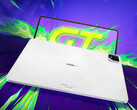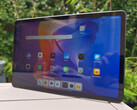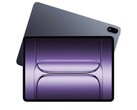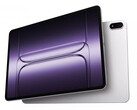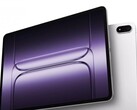Verdict on the OnePlus Pad 2 Pro
Those who don't want to buy the iPad Air 13 for whatever reason will find a perfect and significantly more affordable alternative to the large consumer tablet from Apple in the OnePlus Pad 2 Pro. With its premium tablet, OnePlus offers a similar form factor as the iPad Air but the better LCD screen and longer battery life as well as a respectable plus in graphics performance. In addition, OnePlus can also score with Apple users by offering a seamless interaction with MacOS devices and smart software features.
In the midrange price segment also of Android, the Pad 2 Pro delivers an extremely good performance with its Snapdragon 8 Elite, which makes a powerful argument for its purchase compared to the possible alternatives from the high-end segment such as the Galaxy Tab S10 Ultra. But one lack in the equipment should make life hard in everyday operation for some users: the missing fingerprint sensor. This is particularly because the face unlock function is not secure and unfortunately also only works less than optimally in everyday operation.
Those who don't want to buy an import tablet - even though the Pad 2 Pro also offers a German language package and you can easily install the Google PlayStore using the inhouse app store - will find a globally available correspondence to the OnePlus 2 Pro in the Pad 3, although that is more expensive. Generally, the manufacturer doesn't offer a 5G option or locating capabilities via satellite with its premium tablets.
Pros
Cons
Price and Availability
The price of the OnePlus Pad 2 Pro base version with 12 GB working memory and 256 GB flash storage starts from 3,199 Yuan (~$458). At Trading Shenzhen, which provided our test unit, prices start from around $666. In Europe, the OnePlus tablet is offered with almost identical technical specs as the OnePlus Pad 3, although it has Oxygen OS.
Table of Contents
- Verdict on the OnePlus Pad 2 Pro
- Specifications of the OnePlus Pad 2 Pro
- Case - Android tablet with slim bezels
- Equipment - A large tablet with fast USB
- Software - OnePlus tablet with Android 15
- Communication and GNSS - A large tablet without 5G
- Cameras - OnePlus uses 13 MP in the premium tablet
- Accessories and Warranty - Android tablet with included charger
- Input Devices and Operation - A large tablet with pen input
- Display - OnePlus tablet with a sharp screen
- Performance - iPad Air alternative with Qualcomm SoC
- Games - 13-inch tablet also great for gaming
- Emissions - The Android tablet won't get very hot
- Battery Life - The large tablet is quickly recharged
- Notebookcheck Overall Evaluation
- Possible Alternatives in Comparison
Thanks to its similar form factor, the OnePlus Pad 2 Pro is a direct competitor to the Apple iPad Air 13. With its Snapdragon 8 Elite and up to 16 GB of working memory, the Android tablet offers powerful hardware. In addition, an optional keyboard cover including trackpad and stylus allows you to use the Pad 2 Pro for work and as a laptop replacement. But to achieve the fairly affordable price, OnePlus doesn't include these feature elements by default, and we'd miss them in everyday operation.
Specifications of the OnePlus Pad 2 Pro
Case - Android tablet with slim bezels
With a display diagonal of 13.2 inches, the OnePlus Pad 2 Pro offers a lot of screen real estate, but this also makes it a very large tablet, despite its efficient display-to-surface ratio of more than 87%. The small bezels around the display provide it with a modern look. For example, an Apple iPad Air 13 only reaches 86%.
The manufacturer doesn't offer any information on the materials used. The OnePlus Pad 2 Pro still impresses with very good workmanship and its high-quality metal unibody construction. But the OnePlus tablet weighs almost 100 grams (~3.5 oz) more than the Huawei MatePad Pro 13.2 and isn't very comfortable to hold in a single hand at 675 grams (~24 oz).
The matte surface on the back helps to hide fingerprints. The midrange tablet lacks any official protection certification against dust and water.
Equipment - A large tablet with fast USB
The fast USB 3.2 (Gen 1) connection allows you to output image signals to an external monitor simply via DisplayPort adapter. If you like, you can also connect the Pad 2 Pro wirelessly with your TV, for example.
In addition, the back has three contact points to connect the Smart Touch keyboard case. But keep in mind, that this doesn't allow for storage expansion via microSD card either. You can use USB OTG for other external storage media.
OnePlus offers its premium tablet in various versions with 8 GB, 12 GB, or 16 GB of RAM and 256 GB or 512 GB internal UFS 4.0 storage. While the top version uses LPDDR5T with 4,800 MHz, the smaller models are equipped with LPDDR5x RAM (4,266 MHz).
Software - OnePlus tablet with Android 15
At the time of our testing, the OnePlus Pad 2 Pro runs Android 15 supplemented by the inhouse ColorOS 15 user interface and security patches from July 2025. The compatibility with Apple devices, which simplifies sharing of photos and files needs to be emphasized particularly. In addition, the Pad 2 Pro can be used as an external multi-touch display thanks to the "O+ Connect" app. The "Boundless View" function, allowing you to operate three apps simultaneously beyond the display bezels, is also very practical.
The period of software support remains unclear, since the manufacturer does not specify anything on the update guarantee. However, Apple doesn't do this either for its iPad models.
Sustainability
In contrast to Apple, OnePlus clearly has some catching up to do in terms of transparently specifying the materials used, since there is no concrete information on the percentage of recycled materials used. It is also difficult to evaluate the user friendliness in terms of repairs. What is positive, however, is that the packaging of the Pad 2 Pro doesn't include any plastic at all.
Communication and GNSS - A large tablet without 5G
In contrast to high-end models in the Android segment, the Pad 2 Pro doesn't include a GNSS module to determine its exact location, so that the position can only be determined roughly using connected WLAN networks. The OnePlus tablet also lacks an option for a mobile communication module, so you have to use the data connection of the smartphone when you are on the road.
At home, the premium tablet from OnePlus supports the current maximum bandwidth with WiFi 7 but is unable to create a WLAN connection using the fast 6-GHz frequency band. In combination with the Asus ROG Rapture GT-AXE11000, the Pad 2 Pro only communicates in the 2.4 and 5-GHz ranges, although it reaches very high speeds of almost 1,700 Mbit/s when sending in the 5 GHz band thanks to VHT160. However, the OnePlus Pad is significantly slower when receiving data.
| Networking | |
| OnePlus Pad 2 Pro | |
| iperf3 transmit AXE11000 | |
| iperf3 receive AXE11000 | |
| Apple iPad Air 13 2025 | |
| iperf3 transmit AXE11000 6GHz | |
| iperf3 receive AXE11000 6GHz | |
| Samsung Galaxy Tab S10+ | |
| iperf3 transmit AXE11000 | |
| iperf3 receive AXE11000 | |
| iperf3 transmit AXE11000 6GHz | |
| iperf3 receive AXE11000 6GHz | |
| Huawei MatePad Pro 12.2 2025 | |
| iperf3 transmit AXE11000 | |
| iperf3 receive AXE11000 | |
| Vivo Pad 5 Pro | |
| iperf3 transmit AXE11000 | |
| iperf3 receive AXE11000 | |
| Average 802.11 a/b/g/n/ac/ax/be | |
| iperf3 transmit AXE11000 | |
| iperf3 receive AXE11000 | |
| iperf3 transmit AXE11000 6GHz | |
| iperf3 receive AXE11000 6GHz | |
| Average of class Tablet | |
| iperf3 transmit AXE11000 | |
| iperf3 receive AXE11000 | |
| iperf3 transmit AXE11000 6GHz | |
| iperf3 receive AXE11000 6GHz | |
Cameras - OnePlus uses 13 MP in the premium tablet
The 8 MP front camera of the OnePlus 2 Pro is equipped with a fix-focus and delivers solid results in daylight. The 13 MP main camera on the back succeeds in creating slightly better pictures in sufficient light conditions. However, the dynamic of the image isn't always optimal, which becomes noticeable in slightly flat image areas. The color accuracy and sharpness of details are okay for a tablet, although the Pad 2 Pro deviates visibly from the reference values particularly with blue color tones.
Users will most likely use the camera mainly to take pictures of documents or notes. To do this, the camera app offers a special mode that facilitates taking pictures of such content.
Image comparison
Choose a scene and navigate within the first image. One click changes the position on touchscreens. One click on the zoomed-in image opens the original in a new window. The first image shows the scaled photograph of the test device.
Main CameraMain CameraLow Light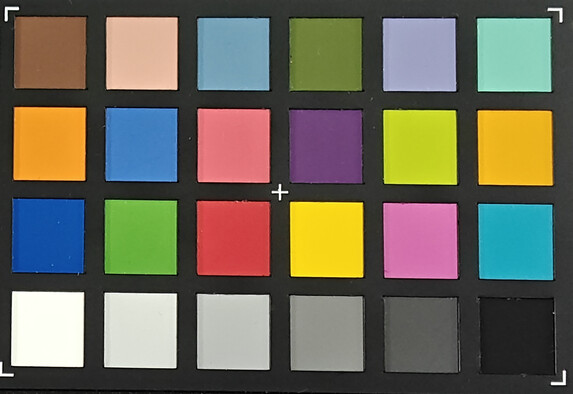

Accessories and Warranty - Android tablet with included charger
The box of the Pad 2 Pro already includes a 67-Watt quick charger as well as a USB-C-to-USB-A cable for data transfer and charging. If you plan to use the OnePlus tablet for work, you can purchase the OnePlus Smart Stylus Pro with 16,000 pressure levels and a very low latency of only 2 ms, as well as a QWERTY keyboard cover as optional accessories. Probably, the Oppo Pencil 2 Pro of the Oppo Pad 4 Pro or the OnePlus Stylo 2 of the Pad 3 should also work with the OnePlus tablet.
Our test unit was loaned to us by Trading Shenzhen, who added an EU adapter for the Chinese charger and a USB-OTG adapter to the default accessories included. In Germany, the import device can be sent to a German address for repair in the context of the 12-month warranty, which simplifies servicing for German customers significantly.
Input Devices and Operation - A large tablet with pen input
OnePlus does some cost cutting in the Pad 2 Pro by leaving out some comfort functions. While the lack of a vibration motor is still bearable in a large 13.2-inch tablet, biometric unlocking exclusively using 2D face recognition via the front camera is surely a dealbreaker for some users in everyday operation. Not only does the tablet lack a fingerprint sensor, which is surprising considering the price class, but the face-unlock function doesn't work reliably in our test - even in good light conditions. We would have liked a capacitive sensor in the power button from OnePlus here.
On the other hand, the input devices of the premium tablet are convincing. Finger inputs are implemented very quickly and accurately. The scan rate of the panel reaches up to 540 Hz, with the touchscreen recognizing touch inputs 120 times per second by default. This ensures a smooth and responsive operation, and the high refresh rate of 144 Hz also makes the animations of the ColorOS user interface look very smooth.
With a side ratio of 7:5, the display format follows the classic book page format (approx. DIN A5), which makes it very suitable for productive tasks. This format, which is much wider compared to the 16:9 panels of many Samsung Galaxy Tabs, offers a larger viewing area particularly when reading documents or surfing the Internet.
Display - OnePlus tablet with a sharp screen
With a resolution of 3,392 x 2,400 pixels, the 13.2-inch display of the OnePlus tablet reaches a high pixel density of 315 PPI, which is considerably higher than the "magic" limit of 300 PPI. For comparison, the iPad Pro 13 only reaches 264 PPI.
We should emphasize as particularly positive that the 12-bit panel doesn't show any PWM flickering, which is a great advantage mainly for sensitive users, leading to a more comfortable viewing experience and allowing for longer usage periods. The Pad 2 Pro offers an LCD panel with an adaptive refresh rate of up to 144 Hz that can be reduced to 60 Hz to save battery power when necessary.
OnePlus specifies a maximum brightness of 600 cd/m², and this is also reached with a pure white background in our test. For the APL18 pattern, which is more relevant in practice, the display reaches a strong 929 cd/m², which corresponds almost exactly to the advertised top brightness of 900 nits.
| |||||||||||||||||||||||||
Brightness Distribution: 87 %
Center on Battery: 691 cd/m²
Contrast: 1152:1 (Black: 0.6 cd/m²)
ΔE ColorChecker Calman: 2.01 | ∀{0.5-29.43 Ø4.78}
ΔE Greyscale Calman: 1.7 | ∀{0.09-98 Ø5}
97.1% sRGB (Calman 2D)
Gamma: 2.193
CCT: 6615 K
| OnePlus Pad 2 Pro LTPS LCD, 3392x2400, 13.2" | Apple iPad Air 13 2025 IPS, 2732x2048, 12.9" | Samsung Galaxy Tab S10+ Dynamic AMOLED 2X, 2800x1752, 12.4" | Huawei MatePad Pro 12.2 2025 Tandem OLED, 2800x1840, 12.2" | Vivo Pad 5 Pro IPS, 3096x2064, 13" | |
|---|---|---|---|---|---|
| Screen | -3% | -41% | 22% | -1% | |
| Brightness middle (cd/m²) | 691 | 607 -12% | 471 -32% | 1036 50% | 683 -1% |
| Brightness (cd/m²) | 643 | 576 -10% | 473 -26% | 1039 62% | 668 4% |
| Brightness Distribution (%) | 87 | 87 0% | 97 11% | 94 8% | 94 8% |
| Black Level * (cd/m²) | 0.6 | 0.5 17% | 0.5 17% | ||
| Contrast (:1) | 1152 | 1214 5% | 1366 19% | ||
| Colorchecker dE 2000 * | 2.01 | 1.52 24% | 3.1 -54% | 1.4 30% | 1.9 5% |
| Colorchecker dE 2000 max. * | 2.86 | 3.5 -22% | 5.8 -103% | 2.6 9% | 3.42 -20% |
| Greyscale dE 2000 * | 1.7 | 2.2 -29% | 2.4 -41% | 2.2 -29% | 2.4 -41% |
| Gamma | 2.193 100% | 2.197 100% | 2.06 107% | 2.22 99% | 2.378 93% |
| CCT | 6615 98% | 6929 94% | 6746 96% | 6829 95% | 6867 95% |
* ... smaller is better
Screen Flickering / PWM (Pulse-Width Modulation)
| Screen flickering / PWM not detected | |||
In comparison: 53 % of all tested devices do not use PWM to dim the display. If PWM was detected, an average of 8121 (minimum: 5 - maximum: 343500) Hz was measured. | |||
We measure a black value of 0.6 cd/m² for the panel of the Pad 2 Pro, which leads to a good but not exceptional contrast ratio of around 1:1200. The ensures sufficient depth in black color tones, although it doesn't reach the powerful contrast values of the OLED competitors.
Color OS offers a wide range of setting options for the color display. In addition to predefined color profiles, you can also adjust the color temperature and color space individually. Despite the multitude of options, there are some slight deviations in the display of the separate colors in the comparatively small sRGB color space.
Display Response Times
| ↔ Response Time Black to White | ||
|---|---|---|
| 15.3 ms ... rise ↗ and fall ↘ combined | ↗ 9.4 ms rise | |
| ↘ 5.9 ms fall | ||
| The screen shows good response rates in our tests, but may be too slow for competitive gamers. In comparison, all tested devices range from 0.1 (minimum) to 240 (maximum) ms. » 35 % of all devices are better. This means that the measured response time is better than the average of all tested devices (20.2 ms). | ||
| ↔ Response Time 50% Grey to 80% Grey | ||
| 33 ms ... rise ↗ and fall ↘ combined | ↗ 21 ms rise | |
| ↘ 12 ms fall | ||
| The screen shows slow response rates in our tests and will be unsatisfactory for gamers. In comparison, all tested devices range from 0.165 (minimum) to 636 (maximum) ms. » 43 % of all devices are better. This means that the measured response time is similar to the average of all tested devices (31.6 ms). | ||
The viewing angle stability of the Pad 2 Pro is very good, so that the display remains fairly undistorted even from steep viewing angles. With a completely black display, we only see some slight clouding that is hardly noticeable in every day operation.
The 13.2-inch LCD panel offers sufficient brightness for outdoor use to make the contents easily readable even in daylight. However, the reflections on the glass surface can become annoying, which limits readability in direct sunlight.
Performance - iPad Air alternative with Qualcomm SoC
OnePlus has equipped its Pad 2 Pro with the Snapdragon 8 Elite. The midrange tablet delivers a very powerful performance in the benchmark tests, easily surpassing the Galaxy Tab S10 Ultra with its MediaTek Dimensity 9300+. In many tests, it even finishes ahead of the iPad Air 13 despite its M3 chip, which is unable to reach the single-core performance of the Pad 2 Pro. On the other hand, the Qualcomm SoC performance is a bit weak in the AI tests.
| CrossMark - Overall | |
| Average Qualcomm Snapdragon 8 Elite (1064 - 2674, n=18) | |
| Samsung Galaxy Tab S10+ | |
| OnePlus Pad 2 Pro | |
| Average of class Tablet (227 - 2155, n=54, last 2 years) | |
| UL Procyon AI Inference for Android - Overall Score NNAPI | |
| Samsung Galaxy Tab S10+ | |
| OnePlus Pad 2 Pro | |
| Average Qualcomm Snapdragon 8 Elite (8865 - 22767, n=17) | |
| Average of class Tablet (2597 - 76852, n=63, last 2 years) | |
| AImark - Score v3.x | |
| Samsung Galaxy Tab S10+ | |
| Average Qualcomm Snapdragon 8 Elite (787 - 307528, n=16) | |
| Average of class Tablet (138 - 55794, n=53, last 2 years) | |
| OnePlus Pad 2 Pro | |
| AI Benchmark - Score V6 | |
| OnePlus Pad 2 Pro | |
| Average Qualcomm Snapdragon 8 Elite (302 - 17293, n=15) | |
| Average of class Tablet (70.4 - 17293, n=28, last 2 years) | |
The premium tablet from OnePlus offers very powerful equipment with its Adreno 830 as the integrated graphics unit. In demanding graphics benchmarks such as the animal tests of GFXBench, it surpasses the Immortalis G720 of the Samsung Galaxy Tab S10 Ultra without any difficulties. Even though the M3 chipset in the iPad Air 13 has to handle a smaller number of pixels, the Apple tablet doesn't even begin to reach the values of the Pad 2 Pro in the tests with a high 4K resolution.
GFXBench (DX / GLBenchmark) 2.7: T-Rex Onscreen | 1920x1080 T-Rex Offscreen
GFXBench 3.0: on screen Manhattan Onscreen OGL | 1920x1080 1080p Manhattan Offscreen
GFXBench 3.1: on screen Manhattan ES 3.1 Onscreen | 1920x1080 Manhattan ES 3.1 Offscreen
GFXBench: on screen Car Chase Onscreen | 1920x1080 Car Chase Offscreen | on screen Aztec Ruins High Tier Onscreen | 2560x1440 Aztec Ruins High Tier Offscreen | on screen Aztec Ruins Normal Tier Onscreen | 1920x1080 Aztec Ruins Normal Tier Offscreen | 3840x2160 4K Aztec Ruins High Tier Offscreen
| 3DMark / Wild Life Extreme Unlimited | |
| OnePlus Pad 2 Pro | |
| Vivo Pad 5 Pro | |
| Samsung Galaxy Tab S10+ | |
| Apple iPad Air 13 2025 | |
| 3DMark / Wild Life Extreme | |
| Apple iPad Air 13 2025 | |
| OnePlus Pad 2 Pro | |
| Vivo Pad 5 Pro | |
| Samsung Galaxy Tab S10+ | |
| 3DMark / Wild Life Unlimited Score | |
| OnePlus Pad 2 Pro | |
| Samsung Galaxy Tab S10+ | |
| Huawei MatePad Pro 12.2 2025 | |
| 3DMark / Solar Bay Score | |
| OnePlus Pad 2 Pro | |
| Vivo Pad 5 Pro | |
| Apple iPad Air 13 2025 | |
| Samsung Galaxy Tab S10+ | |
| 3DMark / Solar Bay Unlimited Score | |
| OnePlus Pad 2 Pro | |
| Apple iPad Air 13 2025 | |
| Vivo Pad 5 Pro | |
| Samsung Galaxy Tab S10+ | |
| 3DMark / Steel Nomad Light Unlimited Score | |
| OnePlus Pad 2 Pro | |
| Vivo Pad 5 Pro | |
| Apple iPad Air 13 2025 | |
| Samsung Galaxy Tab S10+ | |
| Huawei MatePad Pro 12.2 2025 | |
| 3DMark / Steel Nomad Light Score | |
| OnePlus Pad 2 Pro | |
| Vivo Pad 5 Pro | |
| Apple iPad Air 13 2025 | |
| Samsung Galaxy Tab S10+ | |
| Huawei MatePad Pro 12.2 2025 | |
| GFXBench (DX / GLBenchmark) 2.7 / T-Rex Onscreen | |
| Samsung Galaxy Tab S10+ | |
| Apple iPad Air 13 2025 | |
| OnePlus Pad 2 Pro | |
| GFXBench (DX / GLBenchmark) 2.7 / T-Rex Offscreen | |
| Samsung Galaxy Tab S10+ | |
| OnePlus Pad 2 Pro | |
| Apple iPad Air 13 2025 | |
| GFXBench 3.0 / Manhattan Onscreen OGL | |
| Samsung Galaxy Tab S10+ | |
| Apple iPad Air 13 2025 | |
| OnePlus Pad 2 Pro | |
| GFXBench 3.0 / 1080p Manhattan Offscreen | |
| OnePlus Pad 2 Pro | |
| Apple iPad Air 13 2025 | |
| Samsung Galaxy Tab S10+ | |
| GFXBench 3.1 / Manhattan ES 3.1 Onscreen | |
| Samsung Galaxy Tab S10+ | |
| Apple iPad Air 13 2025 | |
| OnePlus Pad 2 Pro | |
| GFXBench 3.1 / Manhattan ES 3.1 Offscreen | |
| OnePlus Pad 2 Pro | |
| Apple iPad Air 13 2025 | |
| Samsung Galaxy Tab S10+ | |
| GFXBench / Car Chase Onscreen | |
| Samsung Galaxy Tab S10+ | |
| Apple iPad Air 13 2025 | |
| OnePlus Pad 2 Pro | |
| GFXBench / Car Chase Offscreen | |
| OnePlus Pad 2 Pro | |
| Apple iPad Air 13 2025 | |
| Samsung Galaxy Tab S10+ | |
| GFXBench / Aztec Ruins High Tier Onscreen | |
| Samsung Galaxy Tab S10+ | |
| Apple iPad Air 13 2025 | |
| OnePlus Pad 2 Pro | |
| Vivo Pad 5 Pro | |
| Huawei MatePad Pro 12.2 2025 | |
| GFXBench / Aztec Ruins High Tier Offscreen | |
| OnePlus Pad 2 Pro | |
| Samsung Galaxy Tab S10+ | |
| Apple iPad Air 13 2025 | |
| Vivo Pad 5 Pro | |
| Huawei MatePad Pro 12.2 2025 | |
| GFXBench / Aztec Ruins Normal Tier Onscreen | |
| Samsung Galaxy Tab S10+ | |
| Vivo Pad 5 Pro | |
| Apple iPad Air 13 2025 | |
| OnePlus Pad 2 Pro | |
| Huawei MatePad Pro 12.2 2025 | |
| GFXBench / Aztec Ruins Normal Tier Offscreen | |
| OnePlus Pad 2 Pro | |
| Apple iPad Air 13 2025 | |
| Vivo Pad 5 Pro | |
| Samsung Galaxy Tab S10+ | |
| Huawei MatePad Pro 12.2 2025 | |
| GFXBench / 4K Aztec Ruins High Tier Offscreen | |
| OnePlus Pad 2 Pro | |
| Samsung Galaxy Tab S10+ | |
| Vivo Pad 5 Pro | |
| Apple iPad Air 13 2025 | |
| Huawei MatePad Pro 12.2 2025 | |
The Pad 2 Pro impresses with a very high browser speed and solid benchmark results in the test. In everyday operation, websites are loaded quickly and can be scrolled smoothly without any stutters, resulting in an attractive surfing experience.
| Jetstream 2 - 2.0 Total Score | |
| Apple iPad Air 13 2025 (Safari 18) | |
| Average Qualcomm Snapdragon 8 Elite (75.1 - 329, n=17) | |
| Huawei MatePad Pro 12.2 2025 (Chrome 137, Performance Mode) | |
| Huawei MatePad Pro 12.2 2025 (Chrome 137) | |
| Samsung Galaxy Tab S10+ (Chrome 130) | |
| Average of class Tablet (22.3 - 395, n=67, last 2 years) | |
| Speedometer 2.0 - Result 2.0 | |
| Apple iPad Air 13 2025 (Safari 18) | |
| Average Qualcomm Snapdragon 8 Elite (244 - 603, n=9) | |
| Samsung Galaxy Tab S10+ (Chrome 130) | |
| Average of class Tablet (2.59 - 790, n=56, last 2 years) | |
| Speedometer 3 - Score 3.0 | |
| Apple iPad Air 13 2025 (Safari 18) | |
| Average Qualcomm Snapdragon 8 Elite (15.3 - 36.8, n=16) | |
| OnePlus Pad 2 Pro (Chrome 138) | |
| Samsung Galaxy Tab S10+ (Chrome 130) | |
| Average of class Tablet (1.25 - 49.1, n=64, last 2 years) | |
| WebXPRT 4 - Overall | |
| Samsung Galaxy Tab S10+ (Chrome 130) | |
| OnePlus Pad 2 Pro (Chrome 138) | |
| Average Qualcomm Snapdragon 8 Elite (102 - 255, n=17) | |
| Average of class Tablet (26 - 376, n=72, last 2 years) | |
| Octane V2 - Total Score | |
| Apple iPad Air 13 2025 (Safari 18) | |
| Vivo Pad 5 Pro (Chrome 137) | |
| Average Qualcomm Snapdragon 8 Elite (25448 - 95506, n=24) | |
| Samsung Galaxy Tab S10+ (Chrome 130) | |
| OnePlus Pad 2 Pro (Chrome 138) | |
| Average of class Tablet (763 - 138481, n=96, last 2 years) | |
| Mozilla Kraken 1.1 - Total | |
| Average of class Tablet (243 - 27101, n=81, last 2 years) | |
| OnePlus Pad 2 Pro (Chrome 138) | |
| Samsung Galaxy Tab S10+ (Chrome 130) | |
| Average Qualcomm Snapdragon 8 Elite (383 - 1170, n=19) | |
| Apple iPad Air 13 2025 (Safari 18) | |
* ... smaller is better
The UFS 4.0 storage of the OnePlus tablet offers a very high speed when accessing the stored data. Despite some great results in the AndroBench tests, we still see some room for improvement for the Pad 2 Pro when reading and writing smaller data blocks.
| OnePlus Pad 2 Pro | Samsung Galaxy Tab S10+ | Huawei MatePad Pro 12.2 2025 | Vivo Pad 5 Pro | Average 256 GB UFS 4.0 Flash | Average of class Tablet | |
|---|---|---|---|---|---|---|
| AndroBench 3-5 | -28% | 11% | 15% | 5% | -39% | |
| Sequential Read 256KB (MB/s) | 3864.83 | 3574.3 -8% | 2110.35 -45% | 4088.5 6% | 3664 ? -5% | 1786 ? -54% |
| Sequential Write 256KB (MB/s) | 3317.21 | 554.67 -83% | 1988.5 -40% | 3095.4 -7% | 2701 ? -19% | 1334 ? -60% |
| Random Read 4KB (MB/s) | 303.59 | 218.43 -28% | 340.83 12% | 295.8 -3% | 381 ? 25% | 244 ? -20% |
| Random Write 4KB (MB/s) | 345.84 | 374.09 8% | 745.32 116% | 562.5 63% | 405 ? 17% | 278 ? -20% |
Games - 13-inch tablet also great for gaming
The results in the graphics benchmarks leads us to think that the Pad 2 Pro should be well-equipped for even some demanding gaming. We evaluate whether this is the case using some current Android games while we determine the exact frame rates for two games from the PlayStore with the help of our partner, GameBench. OnePlus specifies that HFR gaming is possible at 120 FPS for some particular games with the Pad 2 Pro.
With PUBG Mobile, the well-known Battle Royale game, the OnePlus tablet reaches frame rates beyond 100 FPS at low detail settings, coming close to the specified 120-FPS mark. The frame rates of the graphically demanding Genshin Impact show that cooling doesn't become a problem during gaming: the game runs constantly at the maximum possible 60 FPS in the highest graphics quality.
Emissions - The Android tablet won't get very hot
Temperatures
The OnePlus Pad 2 Pro benefits from its large metal case, which provides sufficient area for effective cooling of the Qualcomm SoC. With a combination of graphite and vapor chamber cooling, the Pad 2 Pro succeeds in easily cooling the high temperatures of the Snapdragon 8 Elite even during longer loads. Aside from a small hot spot, the case temperatures remain comfortably low at below 40 °C (104 °F).
Due to the efficient cooling, the performance throttling remains relatively low at around 4 to 14% in the 3DMark stress tests. The performance in everyday operation is not noticeably impacted by this reduction.
(+) The maximum temperature on the upper side is 39.4 °C / 103 F, compared to the average of 33.7 °C / 93 F, ranging from 20.7 to 53.2 °C for the class Tablet.
(±) The bottom heats up to a maximum of 42.3 °C / 108 F, compared to the average of 33.2 °C / 92 F
(+) In idle usage, the average temperature for the upper side is 26.9 °C / 80 F, compared to the device average of 30 °C / 86 F.
3DMark Steel Nomad Stress Test
| 3DMark | |
| Wild Life Stress Test Stability | |
| Huawei MatePad Pro 12.2 2025 | |
| OnePlus Pad 2 Pro | |
| Vivo Pad 5 Pro | |
| Samsung Galaxy Tab S10+ | |
| Wild Life Extreme Stress Test | |
| OnePlus Pad 2 Pro | |
| Apple iPad Air 13 2025 | |
| Vivo Pad 5 Pro | |
| Samsung Galaxy Tab S10+ | |
| Solar Bay Stress Test Stability | |
| OnePlus Pad 2 Pro | |
| Apple iPad Air 13 2025 | |
| Vivo Pad 5 Pro | |
| Samsung Galaxy Tab S10+ | |
| Steel Nomad Light Stress Test Stability | |
| Huawei MatePad Pro 12.2 2025 | |
| Apple iPad Air 13 2025 | |
| OnePlus Pad 2 Pro | |
| Vivo Pad 5 Pro | |
| Samsung Galaxy Tab S10+ | |
Speaker
OnePlus has equipped its premium tablet with a great audio system that includes eight speakers and delivers present mids and some light bass. Two tweeters and woofers each ensure a powerful sound. On the other hand, our Pink Noise measurement shows that it doesn't quite reach the low and full sound levels offered by other flagship tablets.
Not only does the Pad 2 Pro convince audiophile users with its speaker system but also with its extensive support of Bluetooth codecs. It offers Bluetooth 5.4 including SBC, AAC, aptX, aptX HD, aptX Adaptive, LDAC, and LHDC. A USB-C port is available for wired audio transfer, allowing you to connect headphones or external speakers.
OnePlus Pad 2 Pro audio analysis
(+) | speakers can play relatively loud (86.3 dB)
Bass 100 - 315 Hz
(±) | reduced bass - on average 13.2% lower than median
(±) | linearity of bass is average (7% delta to prev. frequency)
Mids 400 - 2000 Hz
(+) | balanced mids - only 4% away from median
(+) | mids are linear (4.1% delta to prev. frequency)
Highs 2 - 16 kHz
(+) | balanced highs - only 2.2% away from median
(+) | highs are linear (5.1% delta to prev. frequency)
Overall 100 - 16.000 Hz
(+) | overall sound is linear (11.5% difference to median)
Compared to same class
» 13% of all tested devices in this class were better, 5% similar, 82% worse
» The best had a delta of 7%, average was 20%, worst was 129%
Compared to all devices tested
» 7% of all tested devices were better, 2% similar, 91% worse
» The best had a delta of 4%, average was 24%, worst was 134%
Apple iPad Air 13 2025 audio analysis
(±) | speaker loudness is average but good (77.7 dB)
Bass 100 - 315 Hz
(±) | reduced bass - on average 5.3% lower than median
(±) | linearity of bass is average (13.6% delta to prev. frequency)
Mids 400 - 2000 Hz
(+) | balanced mids - only 3.8% away from median
(+) | mids are linear (6% delta to prev. frequency)
Highs 2 - 16 kHz
(+) | balanced highs - only 2.5% away from median
(±) | linearity of highs is average (7.5% delta to prev. frequency)
Overall 100 - 16.000 Hz
(+) | overall sound is linear (10.7% difference to median)
Compared to same class
» 8% of all tested devices in this class were better, 4% similar, 87% worse
» The best had a delta of 7%, average was 20%, worst was 129%
Compared to all devices tested
» 5% of all tested devices were better, 2% similar, 93% worse
» The best had a delta of 4%, average was 24%, worst was 134%
Battery Life - The large tablet is quickly recharged
Power Consumption
The battery of the Pad 2 Pro can be recharged at a maximum of 67 watts, with wireless charging not being supported. The midrange tablet is recharged quickly using the included charger. In our test, it takes about 90 minutes to completely recharge the tablet. Despite its slim case, the Pad 2 Pro offers a large battery capacity of 12,140 mAh.
At less than 4 watts during idle operation, the power consumption is at a good level. It is also interesting that despite delivering higher values in GFXbench, the OnePlus tablet consumes less power than an iPad Air 13.
| Off / Standby | |
| Idle | |
| Load |
|
Key:
min: | |
| OnePlus Pad 2 Pro 12140 mAh | Apple iPad Air 13 2025 mAh | Samsung Galaxy Tab S10+ 10090 mAh | Huawei MatePad Pro 12.2 2025 5050 mAh | Average Qualcomm Snapdragon 8 Elite | Average of class Tablet | |
|---|---|---|---|---|---|---|
| Power Consumption | -37% | -8% | 59% | 40% | 13% | |
| Idle Minimum * (Watt) | 3.8 | 2.1 45% | 3.05 20% | 1.2 68% | 1.101 ? 71% | 2.03 ? 47% |
| Idle Average * (Watt) | 4.2 | 8.3 -98% | 4.57 -9% | 1.99 53% | 1.672 ? 60% | 3.9 ? 7% |
| Idle Maximum * (Watt) | 4.8 | 8.5 -77% | 4.65 3% | 2.05 57% | 1.893 ? 61% | 4.26 ? 11% |
| Load Average * (Watt) | 10.2 | 11.9 -17% | 13.35 -31% | 8.88 ? 13% | 9.17 ? 10% | |
| Load Maximum * (Watt) | 12.4 | 16.9 -36% | 15.55 -25% | 13 ? -5% | 13.5 ? -9% |
* ... smaller is better
Power Consumption: Geekbench (150 cd/m²)
Power Consumption: GFXbench (150 cd/m²)
Battery Life
The Pad 2 Pro not only offers a large battery, but the battery life is also remarkably long for a tablet with a screen larger than 13 inches. With the display brightness adjusted to 150 cd/m², the tablet reaches a runtime of almost 24 hours in our WLAN test. When playing videos in a constant loop, the battery also lasts for an impressively long time.
| OnePlus Pad 2 Pro 12140 mAh | Apple iPad Air 13 2025 mAh | Samsung Galaxy Tab S10+ 10090 mAh | Huawei MatePad Pro 12.2 2025 5050 mAh | Vivo Pad 5 Pro 12010 mAh | |
|---|---|---|---|---|---|
| Battery runtime | -32% | -65% | -48% | -20% | |
| Reader / Idle (h) | 46.6 | 25.5 -45% | |||
| H.264 (h) | 24.4 | 13.8 -43% | |||
| WiFi v1.3 (h) | 23.7 | 13.2 -44% | 8.4 -65% | 12.4 -48% | 19 -20% |
| Load (h) | 4.8 | 5 4% |
Notebookcheck Overall Evaluation
The OnePlus Pad 2 Pro represents an excellent LCD alternative to the OLED tablets in the Android segment and also a first-rate alternative to the iPad Air 13 at a significantly more affordable price.
OnePlus Pad 2 Pro
- 07/26/2025 v8
Marcus Herbrich
Possible Alternatives in Comparison
Image | Model / Review | Price | Weight | Drive | Display |
|---|---|---|---|---|---|
| OnePlus Pad 2 Pro Qualcomm Snapdragon 8 Elite ⎘ Qualcomm Adreno 830 ⎘ 12 GB Memory, 256 GB | Amazon: 1. $54.99 Magnetic Detachable Case wit... 2. $24.98 DWaybox for OnePlus Pad 2 Ca... 3. $12.99 KEANBOLL 2-Pack Anti-Blue Li... List Price: 550€ | 675 g | 256 GB UFS 4.0 Flash | 13.20" 3392x2400 315 PPI LTPS LCD | |
| Apple iPad Air 13 2025 Apple M3 ⎘ Apple M3 9-Core GPU ⎘ 8 GB Memory, 128 GB NVMe | Amazon: $699.00 List Price: 949€ | 616 g | 128 GB NVMe | 12.90" 2732x2048 265 PPI IPS | |
| Samsung Galaxy Tab S10+ MediaTek Dimensity 9300+ ⎘ ARM Immortalis-G720 MP12 ⎘ 12 GB Memory, 256 GB | Amazon: 1. $749.99 Samsung Galaxy Tab S10+ Plus... 2. $324.29 SAMSUNG Galaxy Tab S10 FE 12... 3. $299.99 Samsung Galaxy Tab S10 Lite,... List Price: 1119€ | 571 g | 256 GB UFS 4.0 Flash | 12.40" 2800x1752 266 PPI Dynamic AMOLED 2X | |
| Huawei MatePad Pro 12.2 2025 HiSilicon Kirin T92 ⎘ HiSilicon Maleoon 920 ⎘ 12 GB Memory, 512 GB | Amazon: 1. $16.89 WUNIAK Screen Protector for ... 2. $22.65 Case Compatible with Huawei ... 3. $33.99 BLCshine 360° Magnetic Priv... List Price: 999€ | 508 g | 512 GB UFS 3.1 Flash | 12.20" 2800x1840 275 PPI Tandem OLED | |
| Vivo Pad 5 Pro Mediatek Dimensity 9400 ⎘ ARM Immortalis-G925 MC12 ⎘ 16 GB Memory, 512 GB | Amazon: 1. $28.90 for vivo Pad 5 Pro 13"(2025)... 2. $30.64 yixinA for vivo Pad 5 Pro 13... 3. $26.27 BailiTao for vivo Pad 5 Pro ... List Price: 699€ | 578 g | 512 GB UFS 4.1 Flash | 13.00" 3096x2064 286 PPI IPS |
Transparency
The selection of devices to be reviewed is made by our editorial team. The test sample was provided to the author as a loan by the manufacturer or retailer for the purpose of this review. The lender had no influence on this review, nor did the manufacturer receive a copy of this review before publication. There was no obligation to publish this review. As an independent media company, Notebookcheck is not subjected to the authority of manufacturers, retailers or publishers.
This is how Notebookcheck is testing
Every year, Notebookcheck independently reviews hundreds of laptops and smartphones using standardized procedures to ensure that all results are comparable. We have continuously developed our test methods for around 20 years and set industry standards in the process. In our test labs, high-quality measuring equipment is utilized by experienced technicians and editors. These tests involve a multi-stage validation process. Our complex rating system is based on hundreds of well-founded measurements and benchmarks, which maintains objectivity. Further information on our test methods can be found here.




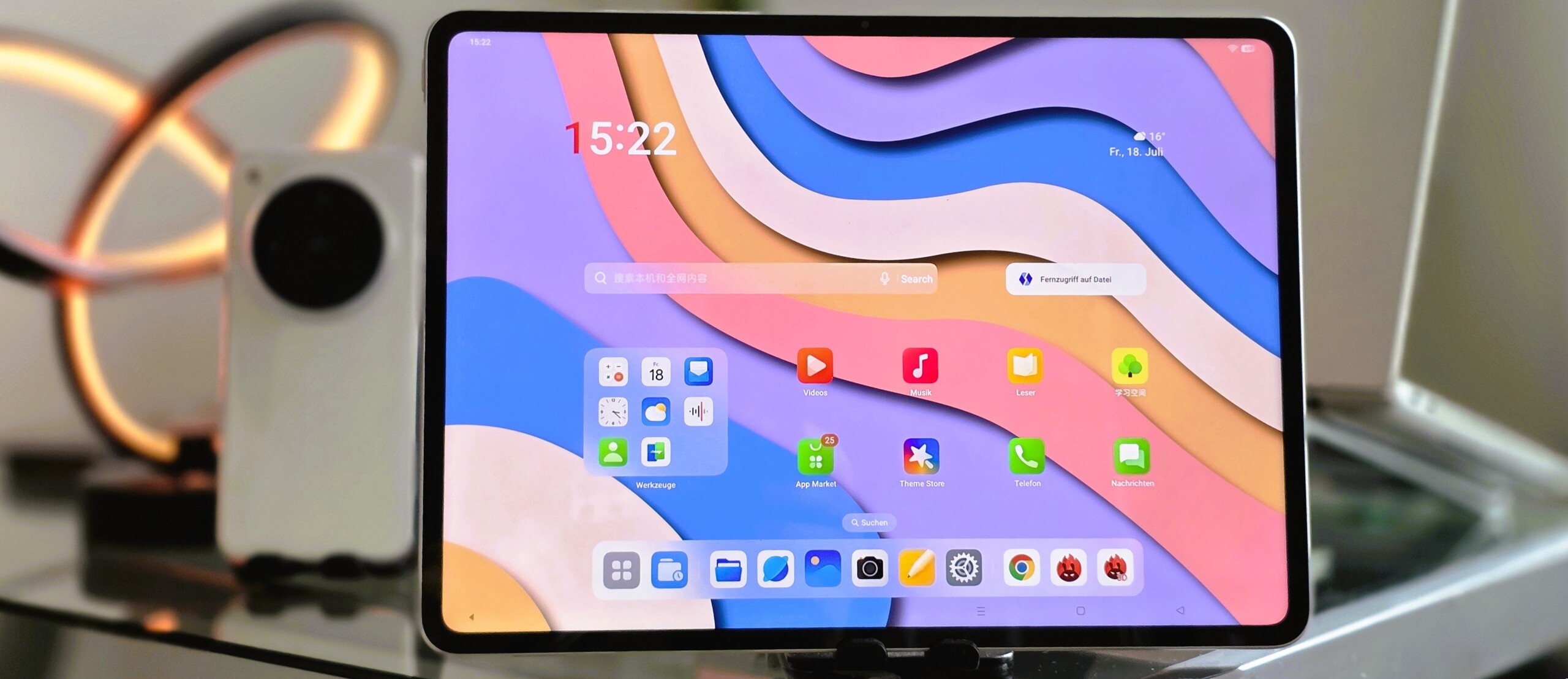


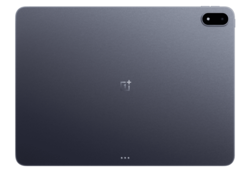
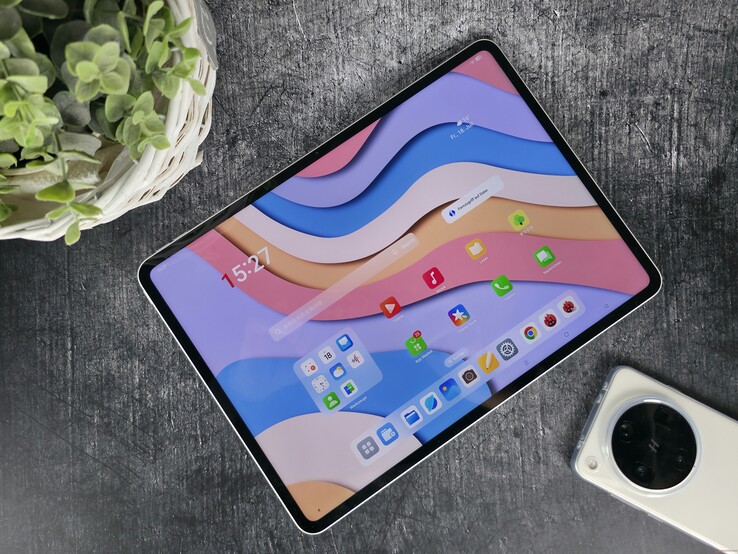







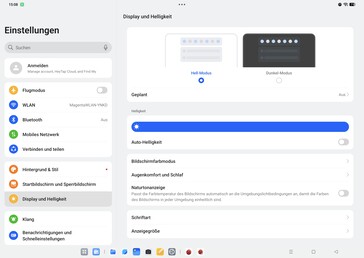


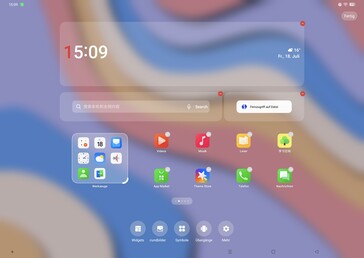

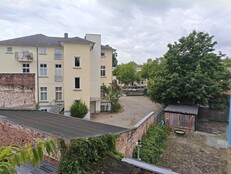



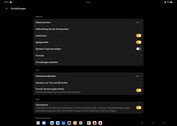



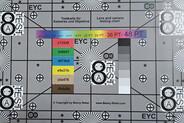



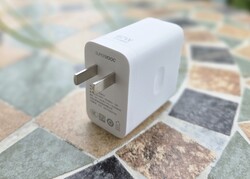
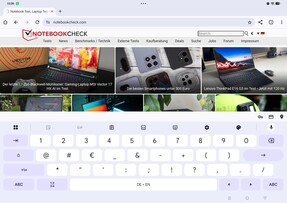
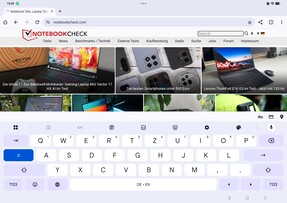



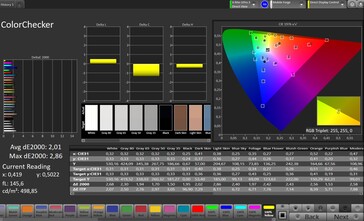
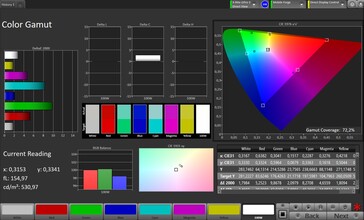


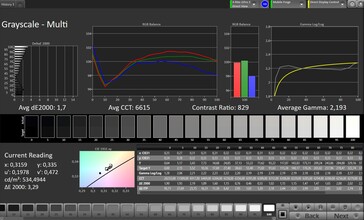
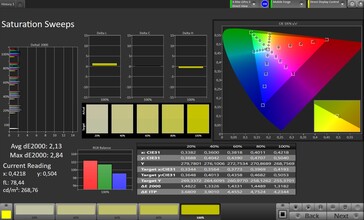


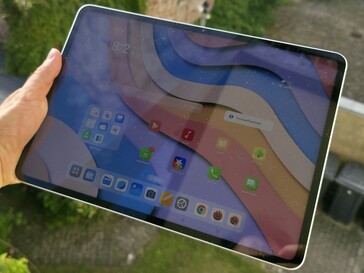
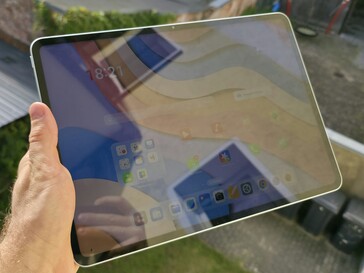





 Total Sustainability Score:
Total Sustainability Score: 






